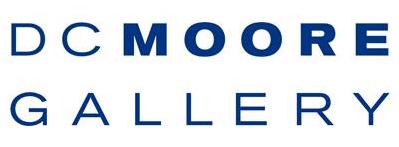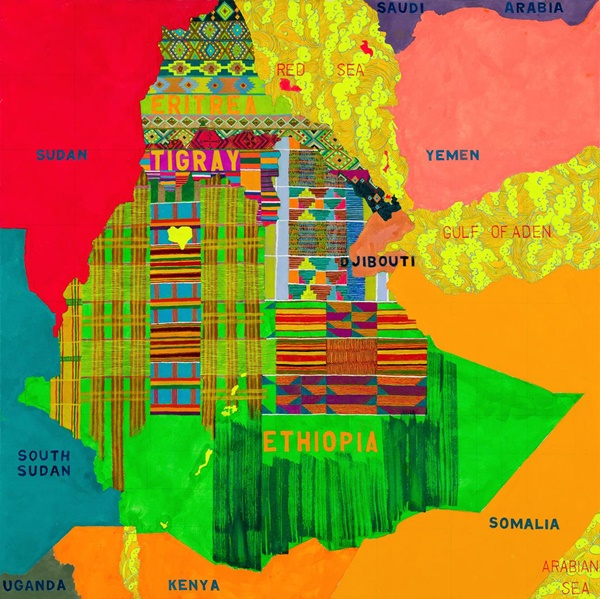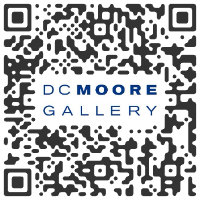"Collateral Damage" Joyce Kozloff 

Tel 212 247 2111 Fax 212 247 2119 e-mail:This email address is being protected from spambots. You need JavaScript enabled to view it.






Opening reception with the artist on Saturday, January 6, from 3 - 5 pm

DC Moore Gallery
535 West 22nd Street, 2nd Floor New York, NY 10011Tel 212 247 2111 Fax 212 247 2119 e-mail:



January 6 – February 3, 2024



Joyce Kozloff has long addressed political, economic, and cultural divides through her mixed-media practice. Since the early 1990s, Kozloff has used mapping as a framework to build upon enduring interests in decorative arts, history, popular culture, and political struggles. Joyce Kozloff: Collateral Damage presents a new series of paintings alongside recent and earlier works about war, centering her continual innovation and expansion of the category of political art. The works in this exhibition utilize the changing iconographies and technologies of mapping to chart patterns of power, drawing from ancient atlases to contemporary Google imaging.
Kozloff’s latest series of paintings, “Collateral Damage,” focuses on the targeted destruction of life and cultural heritage in ongoing conflicts. Painting maps of countries currently at war, Kozloff covers the most fought over areas with images from textiles and architectural ornament. These works represent the less tangible losses of communal memory, the destruction of history and culture caused by the killing of individuals. These richly colorful and complex paintings do not evoke the destruction of specific historic monuments, museums, and other institutions, but the material culture of everyday life and the traditions that are at risk of eradication. Kozloff comments, “I hope to make connections that will communicate with others. ‘Collateral Damage’ is about current conflicts, many of which are proxy wars– over borders, resources, ethnic and religious differences, regional and global power. People, families, communities, and their collective histories are the losers: I want to memorialize them, as they disappear.”
Kozloff takes advantage of the inherent distortions and decorative qualities of maps, altering the dimensionality of the two-dimensional surface to reflect the flattening of the globe, and inflecting personal meaning and political associations through her own visual language. The large-scale painting Spheres of Influence (2001) is made of twelve narrow, convex canvases joined together. Based on an atlas of the ancient Roman Empire, Kozloff painted a different region of the Mediterranean on each canvas, overlapped with imagery drawn from U.S. Government Tactical Pilotage Charts, topographical maps with aeronautical information. In 2003, upon the United States’ invasion of Iraq, Kozloff created her mixed-media sculpture, Rocking the Cradle. Inside an oversized wooden cradle, she painted a baby-blue map of Iraq, with overlapping lines diagramming American troop movements tightly encircling Baghdad. Years later, in collaboration with composer Carolyn Yarnell, Kozloff added a recording of music which quietly plays as the cradle rocks, an elegiac commemoration of the Iraqi people killed in the war.
Also on display are studies for Kozloff’s 2021 General Services Administration commission for a federal courthouse in Greenville, South Carolina. Titled Memory and Time: Labor and Cultural History, the installation weaves together cartography with the history of craft and labor in Greenville, which was known as the “textile capital of the world” in the nineteenth and early twentieth centuries. The centerpiece of the installation is a three-panel aerial view of the ruins of Chiquola Mill, site of the 1934 Bloody Thursday massacre of striking textile workers. Local workers participated in a nationwide textile strike, the largest in the history of the United States. A local militia, organized by the mayor opened fire against the unarmed picketers, killing seven and wounding thirty. Afterwards, a gag rule was imposed on mill workers returning to the factory. The public outcry in response to this violent massacre led to New Deal legislation regulating working hours, child labor, and the minimum wage.
Around the courthouse lobby, ceramic tile panels depict surviving textile mills in the region, as viewed from Google Earth, overlaid with a painted weave pattern from a fabric produced in that mill. Below, on glass mosaic panels, Kozloff surrounded historic maps of the area with Cherokee basket patterns and nineteenth century regional quilts, highlighting the history of decorative arts and the changing demographics and power dynamics of the region.
Joyce Kozloff (b. 1942, New Jersey) was a major figure in both the Feminist and Pattern and Decoration movements of the 1970s. She was a founding member of the Heresies collective, which published a quarterly journal about art, feminism, and politics. In 1979, she began to focus on public art and has since executed several major installations in public spaces. Her studio practice encompasses painting, sculpture, installations, printmaking, and photography. Since the early 1990s, Kozloff has used cartography as a device for contextualizing her longstanding interests in systems of power, knowledge production, and popular arts.
An upcoming solo exhibition, Joyce Kozloff: How We Know What We Know at the John Michael Kohler Arts Center in Sheboygan, WI, will be on view from February 2 to June 30, 2024. Recently, Kozloff’s work has been included in several national and international museum exhibitions, including Hokusai: Inspiration and Influence, Museum of Fine Arts, Boston, MA, traveled to the Seattle Art Museum, WA, and Nelson-Atkins Museum of Art, Kansas City, MO (2023-25); Parall(elles): A History of Women in Design, Musée des Beaux-Arts, Montréal, CA (2023); The Big Picture: Repositories of Knowledge & Spaces for Reflection in Contemporary Art, HALLE 14, Leipzig, Germany (2023); Les Flammes: L’art vivant de la ceramique, Musée d’art moderne de la Ville de Paris, France (2022); and With Pleasure: Pattern and Decoration in American Art 1972–1985, Museum of Contemporary Art, LA and the Hessel Museum of Art, Annandale-on-Hudson, NY (2019-2021).
Kozloff’s work is included in numerous public collections, including the Brooklyn Museum of Art, NY; Harvard University Fogg Art Museum, Cambridge, MA; The Jewish Museum, NY; Los Angeles County Museum of Art, CA; Metropolitan Museum of Art, NY; Museum of Contemporary Art, Los Angeles, CA; Museum of Modern Art, NY; National Gallery of Art, Washington, D.C.; Smithsonian American Art Museum, Washington, DC; Pennsylvania Academy of Fine Arts, Philadelphia, PA; Yale University Art Museum, New Haven, CT; and the Whitney Museum of American Art, NY.
Kozloff’s latest series of paintings, “Collateral Damage,” focuses on the targeted destruction of life and cultural heritage in ongoing conflicts. Painting maps of countries currently at war, Kozloff covers the most fought over areas with images from textiles and architectural ornament. These works represent the less tangible losses of communal memory, the destruction of history and culture caused by the killing of individuals. These richly colorful and complex paintings do not evoke the destruction of specific historic monuments, museums, and other institutions, but the material culture of everyday life and the traditions that are at risk of eradication. Kozloff comments, “I hope to make connections that will communicate with others. ‘Collateral Damage’ is about current conflicts, many of which are proxy wars– over borders, resources, ethnic and religious differences, regional and global power. People, families, communities, and their collective histories are the losers: I want to memorialize them, as they disappear.”
Kozloff takes advantage of the inherent distortions and decorative qualities of maps, altering the dimensionality of the two-dimensional surface to reflect the flattening of the globe, and inflecting personal meaning and political associations through her own visual language. The large-scale painting Spheres of Influence (2001) is made of twelve narrow, convex canvases joined together. Based on an atlas of the ancient Roman Empire, Kozloff painted a different region of the Mediterranean on each canvas, overlapped with imagery drawn from U.S. Government Tactical Pilotage Charts, topographical maps with aeronautical information. In 2003, upon the United States’ invasion of Iraq, Kozloff created her mixed-media sculpture, Rocking the Cradle. Inside an oversized wooden cradle, she painted a baby-blue map of Iraq, with overlapping lines diagramming American troop movements tightly encircling Baghdad. Years later, in collaboration with composer Carolyn Yarnell, Kozloff added a recording of music which quietly plays as the cradle rocks, an elegiac commemoration of the Iraqi people killed in the war.
Also on display are studies for Kozloff’s 2021 General Services Administration commission for a federal courthouse in Greenville, South Carolina. Titled Memory and Time: Labor and Cultural History, the installation weaves together cartography with the history of craft and labor in Greenville, which was known as the “textile capital of the world” in the nineteenth and early twentieth centuries. The centerpiece of the installation is a three-panel aerial view of the ruins of Chiquola Mill, site of the 1934 Bloody Thursday massacre of striking textile workers. Local workers participated in a nationwide textile strike, the largest in the history of the United States. A local militia, organized by the mayor opened fire against the unarmed picketers, killing seven and wounding thirty. Afterwards, a gag rule was imposed on mill workers returning to the factory. The public outcry in response to this violent massacre led to New Deal legislation regulating working hours, child labor, and the minimum wage.
Around the courthouse lobby, ceramic tile panels depict surviving textile mills in the region, as viewed from Google Earth, overlaid with a painted weave pattern from a fabric produced in that mill. Below, on glass mosaic panels, Kozloff surrounded historic maps of the area with Cherokee basket patterns and nineteenth century regional quilts, highlighting the history of decorative arts and the changing demographics and power dynamics of the region.
Joyce Kozloff (b. 1942, New Jersey) was a major figure in both the Feminist and Pattern and Decoration movements of the 1970s. She was a founding member of the Heresies collective, which published a quarterly journal about art, feminism, and politics. In 1979, she began to focus on public art and has since executed several major installations in public spaces. Her studio practice encompasses painting, sculpture, installations, printmaking, and photography. Since the early 1990s, Kozloff has used cartography as a device for contextualizing her longstanding interests in systems of power, knowledge production, and popular arts.
An upcoming solo exhibition, Joyce Kozloff: How We Know What We Know at the John Michael Kohler Arts Center in Sheboygan, WI, will be on view from February 2 to June 30, 2024. Recently, Kozloff’s work has been included in several national and international museum exhibitions, including Hokusai: Inspiration and Influence, Museum of Fine Arts, Boston, MA, traveled to the Seattle Art Museum, WA, and Nelson-Atkins Museum of Art, Kansas City, MO (2023-25); Parall(elles): A History of Women in Design, Musée des Beaux-Arts, Montréal, CA (2023); The Big Picture: Repositories of Knowledge & Spaces for Reflection in Contemporary Art, HALLE 14, Leipzig, Germany (2023); Les Flammes: L’art vivant de la ceramique, Musée d’art moderne de la Ville de Paris, France (2022); and With Pleasure: Pattern and Decoration in American Art 1972–1985, Museum of Contemporary Art, LA and the Hessel Museum of Art, Annandale-on-Hudson, NY (2019-2021).
Kozloff’s work is included in numerous public collections, including the Brooklyn Museum of Art, NY; Harvard University Fogg Art Museum, Cambridge, MA; The Jewish Museum, NY; Los Angeles County Museum of Art, CA; Metropolitan Museum of Art, NY; Museum of Contemporary Art, Los Angeles, CA; Museum of Modern Art, NY; National Gallery of Art, Washington, D.C.; Smithsonian American Art Museum, Washington, DC; Pennsylvania Academy of Fine Arts, Philadelphia, PA; Yale University Art Museum, New Haven, CT; and the Whitney Museum of American Art, NY.
Opening reception with the artist on Saturday, January 6, from 3 - 5 pm
mpefm USA art press release
HOURS:
by appointment from Tuesday through Saturday from 10 am to 6 pm
QR of this press release
in your phone, tablet

HOURS:
by appointment from Tuesday through Saturday from 10 am to 6 pm
QR of this press release
in your phone, tablet









